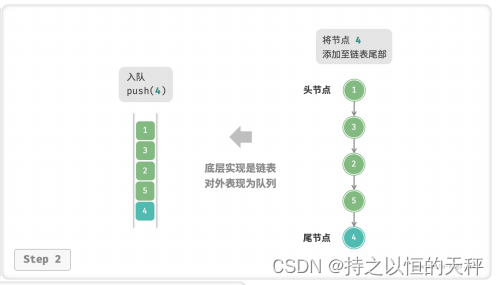
小伙伴们,今天我们来继续学习数据结构的第二部分内容,就是栈和队列了。那么栈和队列有什么用呢?
栈和队列是两种重要的线性结构。从数据结构的角度看,栈和队列也是线性表,其特殊性在于栈和队列的基本操作是线性表操作的子集,它们是操作受限的线性表,因此,可称为具有限定性的数据结构。但从数据类型角度看,它们是和线性表不同的两类重要的抽象数据类型。
首先,我们先来学习栈
1.栈
1.1栈的概念及结构
栈:一种特殊的线性表,其只允许在固定的一端进行插入和删除元素操作。
进行数据插入和删除操作的一端
称为栈顶,另一端称为栈底。
栈中的数据元素遵守
后进先出
LIFO
(
Last In First Out
)的原则。
压栈:栈的插入操作叫做进栈
/
压栈
/
入栈,
入数据在栈顶
。
出栈:栈的删除操作叫做出栈。
出数据也在栈顶
。

1.2栈的实现
栈的实现一般可以使用
数组或者链表实现
,相对而言数组的结构实现更优一些。因为数组在尾上插入数据的代价比较小。

单链表形式
 还是像链表一样,创建3个文件,一个头文件,两个.c文件。我们通过数组来实现栈的创建。
还是像链表一样,创建3个文件,一个头文件,两个.c文件。我们通过数组来实现栈的创建。
首先我们要想的一个问题是初始化时top是为0还是-1?(不要把top理解为数组下标)

先来看一下静态的栈
// 下面是定长的静态栈的结构,实际中一般不实用,所以我们主要实现下面的支持动态增长的栈
typedef int STDataType;
#define N 10
typedef struct Stack
{
STDataType _a[N];
int _top; // 栈顶
}Stack;静态的栈一般很少用到,所以我们对动态的栈进行书写
stack.h
#pragma once
#include<stdio.h>
#include<stdlib.h>
#include<assert.h>
#include<stdbool.h>
typedef int STDataType;
typedef struct Stack
{
STDataType* a;//数组
int top;
int capacity;
}ST;
//初始化
void STInit(ST* pst);
//销毁
void STDestroy(ST* pst);
//入栈
void STPush(ST* pst, STDataType x);
//出栈
void STPop(ST* pst);
//检查是否为空
bool STEmpty(ST* pst);
//获取有效元素个数
int STSize(ST* pst);
//获取栈顶元素
STDataType STTop(ST* pst);stack.c
#define _CRT_SECURE_NO_WARNINGS 1
#include"stack.h"
//初始化
void STInit(ST* pst)
{
assert(pst);
pst->a = NULL;
pst->top = 0;//0时是指向栈顶数据的下一个位置
//pst->top = -1;//-1时是指向栈顶数据
pst->capacity = 0;
}
//销毁
void STDestroy(ST* pst)
{
assert(pst);
free(pst->a);
pst->a = NULL;
pst->top = pst->capacity = 0;
}
//入栈
void STPush(ST* pst, STDataType x)
{
if (pst->top == pst->capacity)
{
int newcapacity = pst->capacity == 0 ? 4 : pst->capacity * 2;
STDataType* tmp = (STDataType*)realloc(pst->a, newcapacity * sizeof(STDataType));
if (tmp == NULL)
{
perror("realloc fail");
return;
}
pst->a = tmp;
pst->capacity = newcapacity;
}
pst->a[pst->top] = x;
pst->top++;
}
//出栈
void STPop(ST* pst)
{
assert(pst);
//如果栈为空时,是true,再取非,说明栈内没有元素,无法出栈就会报错
assert(!STEmpty(pst));
pst->top--;
}
//获取栈顶元素
STDataType STTop(ST* pst)
{
assert(pst);
assert(!STEmpty(pst));
return pst->a[pst->top - 1];
}
//检查是否为空
bool STEmpty(ST* pst)
{
assert(pst);
//方法1
/*if (pst->top == 0)
{
return true;
}
else
{
return false;
}*/
//方法2
return pst->top == 0; //等于0返回true,不等于返回false
}
//获取有效元素个数
int STSize(ST* pst)
{
assert(pst);
return pst->top;
}
test.c
#define _CRT_SECURE_NO_WARNINGS 1
#include"stack.h"
#include<stdio.h>
void TestStack()
{
ST st;
STInit(&st);
STPush(&st, 1);
STPush(&st, 2);
STPush(&st, 3);
STPush(&st, 4);
while (!STEmpty(&st))
{
printf("%d ", STTop(&st));
STPop(&st);
}
STDestroy(&st);
}
int main()
{
TestStack();
return 0;
}
2.队列
2.1 队列的结构及概念
队列:只允许在一端进行插入数据操作,在另一端进行删除数据操作的特殊线性表,队列具有先进先出
FIFO(First In First Out)
入队列:进行插入操作的一端称为
队尾
出队列:进行删除操作的一端称为
队头

2.2 队列的实现
我们这次用单链表来实现队列的实现,当然也可以通过数组来实现。
我们可以将链表的“头节点”和“尾节点”分别视为“队首”和“队尾”,规定队尾仅可添加
节点,队首仅可删除节点。(图片来源:hello算法
)
链接:
hello‑algo.com



首先我们要先定义队列,再定义队列的结构。
//链式结构:表示队列
typedef int QDataType;
typedef struct QueueNode
{
struct QueueNode* next;
QDataType data;
}QNode;
//队列的结构
typedef struct Queue
{
QNode* phead;
QNode* ptail;
int size;
}Queue;另外我们不需要对开辟节点重新写一个函数,因为只需要插入才会开辟新的节点,所以可以直接在插入队列的函数里面开辟节点。
Queue.h
#pragma once
#include<stdlib.h>
#include<assert.h>
#include<stdbool.h>
typedef int QDataType;
typedef struct QueueNode
{
struct QueueNode* next;
QDataType data;
}QNode;
typedef struct Queue
{
QNode* phead;
QNode* ptail;
int size;
}Queue;
//初始化
void QueueInit(Queue* pq);
//销毁
void QueueDestroy(Queue* pq);
//插入队列
void QueuePush(Queue* pq, QDataType x);
//出队列
void QueuePop(Queue* pq);
//寻找队头
QDataType QueueFront(Queue* pq);
//寻找队尾
QDataType QueueBack(Queue* pq);
//计算个数
int QueueSize(Queue* pq);
//检查队列是否为空
bool QueueEmpty(Queue* pq);
Queue.c
#define _CRT_SECURE_NO_WARNINGS 1
#include"Queue.h"
//初始化
void QueueInit(Queue* pq)
{
assert(pq);
pq->phead = NULL;
pq->ptail = NULL;
pq->size = 0;
}
//销毁
void QueueDestroy(Queue* pq)
{
assert(pq);
QNode* cur = pq->phead;
while (cur)
{
QNode* next = cur->next;
free(cur);
cur = next;
}
pq->phead = pq->ptail = NULL;
pq->size = 0;
}
//插入队列
void QueuePush(Queue* pq, QDataType x)
{
assert(pq);
QNode* newnode = (QNode*)malloc(sizeof(QNode));
if (newnode == NULL)
{
perror("malloc fail");
}
newnode->data = x;
newnode->next = NULL;
if (pq->ptail == NULL)
{
assert(pq->phead == NULL);
pq->phead = pq->ptail = newnode;
}
else
{
pq->ptail->next = newnode;
pq->ptail = newnode;
}
pq->size++;
}
//出队列
void QueuePop(Queue* pq)
{
assert(pq);
assert(!QueueEmpty(pq));
//分为一个节点和多个节点
if (pq->phead->next == NULL)
{
free(pq->phead);
pq->phead = pq->ptail == NULL;
}
else
{
QNode* next = pq->phead->next;
free(pq->phead);
pq->phead = next;
}
pq->size--;
}
//寻找队头
QDataType QueueFront(Queue* pq)
{
assert(pq);
assert(!QueueEmpty(pq));
return pq->phead->data;
}
//寻找队尾
QDataType QueueBack(Queue* pq)
{
assert(pq);
assert(!QueueEmpty(pq));
return pq->ptail->data;
}
//计算个数
int QueueSize(Queue* pq)
{
assert(pq);
return pq->size;
}
//检查队列是否为空
bool QueueEmpty(Queue* pq)
{
assert(pq);
return pq->size == 0;
}
tect.c
void TestQueue()
{
Queue q;
QueueInit(&q);
QueuePush(&q, 1);
QueuePush(&q, 2);
QueuePush(&q, 3);
QueuePush(&q, 4);
while (!QueueEmpty(&q))
{
printf("%d ", QueueFront(&q));
QueuePop(&q);
}
printf("\n");
QueueDestroy(&q);
}好了,小伙伴们,这次我们对栈和队列先学到这里,以后我会继续补充一些知识点在这里,一定要记得常回来看看。





















 704
704











 被折叠的 条评论
为什么被折叠?
被折叠的 条评论
为什么被折叠?








